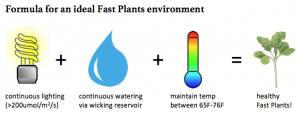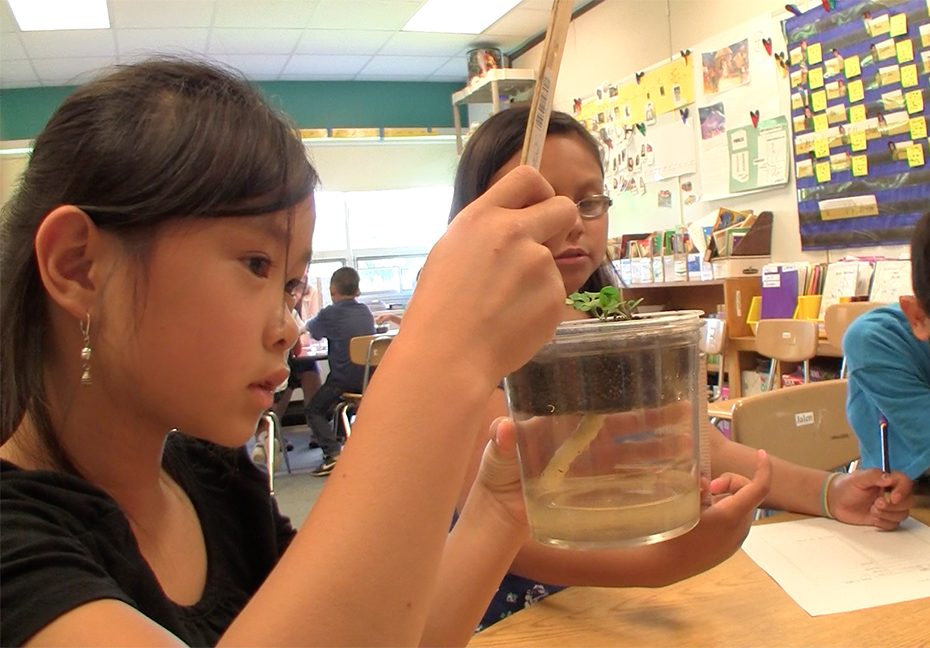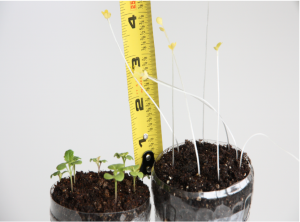Teaching and Learning with Fast Plants Investigations
We know it is important to “help students make sense of the natural world by designing and carrying out authentic, student driven investigations (Wingert & Bell, 2015).” Compared to other living organisms, Wisconsin Fast Plants are easy to manage and very responsive to factors in their environment. In addition, many easy-to-observe Fast Plant phenotypes show evidence from which we can make inferences about the environment. Therefore, growing Fast Plants in controlled and varied environmental conditions is very effective for teaching through investigations what plants need to grow and develop. Also, varying the experimental environment is a valuable way to learn about natural selection and the relationships among genotype, phenotype and variation.
What kinds of investigations can be done in my classroom with Wisconsin Fast Plants?
Whether you’re planning for student-centered investigation design or more guided inquiry, the Wisconsin Fast Plants Program offers online and in our digital library growing protocols for students of all ages. In addition, Carolina Biological Supply distributes Wisconsin Fast Plants Seeds and kits (see lists below). In the following sections, we suggest some tried-and-true questions for investigations into what plants need and preparations for designing environmental investigations.
Investigations to learn about what plants need to grow and develop

Investigations into what plants need can be designed to learn about plants need at all stages of growth and development. In fact, Next Generation Science Standards specify that even Kindergarten students ought to observe and describe patterns of what plants need to survive. For example, investigation into plants needs, for example, can begin with questions such as:
- What do seeds need to germinate?
- How do seedlings develop strong stems and large, green leaves?
- What do roots need for plants to develop a dense root structure?
- How do environmental needs effect flowering and reproduction?
Keep in mind, investigations are accessible to all students when we differentiate the rigor of the underpinning questions. Similarly, we can differentiate the options available for experimental design to support more student-directed investigating.
What Fast Plants kits are available that focus on the plant life cycle and investigations into what plants need?
- Wisconsin Fast Plants Elementary Exploration of Plant Life Cycles
- Reading Green: Investigating the Life Cycle and Growth of Flowering Plants
- Wisconsin Fast Plants Growth, Development, and Reproduction Advanced Student Kit
- Wisconsin Fast Plants Independent Research Kit
Investigations designed to learn about causal relationships between environmental factors and Fast Plants growth and development
Understanding how environmental factors effect growth, development, and variation in populations is fundamental to learning the big ideas in life sciences. Therefore, using Fast Plants as a model organism to investigate the effects of environmental factors is powerful for learners of all ages. Whether you’re guiding students investigations or planning for open-ended, student-centered investigation design, consider the following:
- Learn more about factors of the physical, chemical, and biological environments.
- Then, learn about chemical factors and effects caused by adjusting fertilizer levels.
- Also, learn about measuring the effects of physical factors on plants grown in high and low light, or light and dark.
- Equally important, learn about observing biological/ecological interactions in competition experiments.
- In addition, consider the interactions of Fast Plants with other organisms.




